Do you have a question about the BIOTRONIK Enitra 6 SR and is the answer not in the manual?
Describes the intended medical applications for the Enitra pacemaker family.
Information about using pacemakers in MRI environments.
General contraindications for pacemaker implantation and use.
Discusses contraindicated pacing modes and parameter combinations.
Describes the Enitra pacemaker device family variants.
Explains the standardized lead connection types (IS-1, IS4).
Describes BIOTRONIK leads, their properties, and connection adapters.
Explains telemetric communication between device and programmer.
Details the programmer's functions for implantation and follow-up.
Lists available pacing modes for different device types.
Defines NBG codes for antibradycardia modes (AAIR, VVIR, DDDR, DDDRV).
Describes the BIOTRONIK Home Monitoring therapy management system.
Details diagnostic functions like sensing, pacing thresholds, and IEGM display.
Explains antibradycardia pacing features like capture control and timing.
Describes resynchronization therapy features for triple-chamber devices.
Details how ProMRI devices handle MRI environments.
Describes data transmission and medical information sent by Home Monitoring.
General safety precautions for cardiac electrotherapy.
Information on technical manuals, shipping, storage, temperature, and sterile delivery.
Discusses general complications for patients and device systems.
Lists possible causes of technical failures in the device system.
Discusses device sensitivity to EMI and BIOTRONIK's design.
Explains device behavior during electromagnetic interference.
Lists procedures that may harm the patient or damage the device.
Discusses risks associated with diagnostic/therapeutic procedures and patient insulation.
Explains potential damage from external defibrillation and electrode placement.
Warns about radiation therapy risks and required measures.
Details risks and precautions for MRI scans with pacemaker devices.
Lists required parts and steps for implanting the device.
Specifies the necessary components for implantation.
Emphasizes keeping an external defibrillator available for emergencies.
Provides instructions and warnings for unpacking the device.
Step-by-step overview of the implantation process.
Instructions to prevent damage to the device header during implantation.
Warning and measure to prevent short circuits in open lead connector ports.
Warning about lead spacing to prevent inadequate therapy.
Detailed steps for connecting lead connectors to the device header.
Steps to establish wandless telemetry contact with the programmer.
Describes the automatic initialization process after lead connection.
Guidance on avoiding risky parameter combinations.
Details risks associated with exclusive LV pacing and lead dislodgement.
Warning against unipolar pacing when an ICD is also implanted.
How Home Monitoring supports functional in-office follow-up.
Modes available for devices marked ProMRI.
Preset parameters for the MRI program.
| Brand | BIOTRONIK |
|---|---|
| Model | Enitra 6 SR |
| Category | Medical Equipment |
| Language | English |
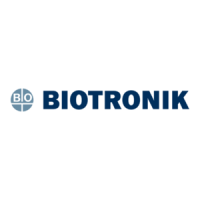

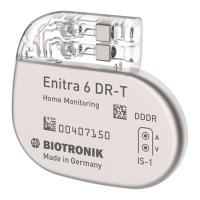





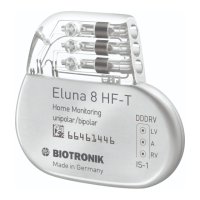
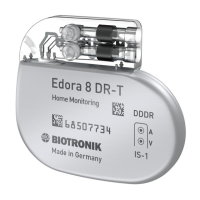

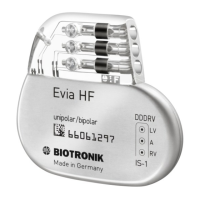
